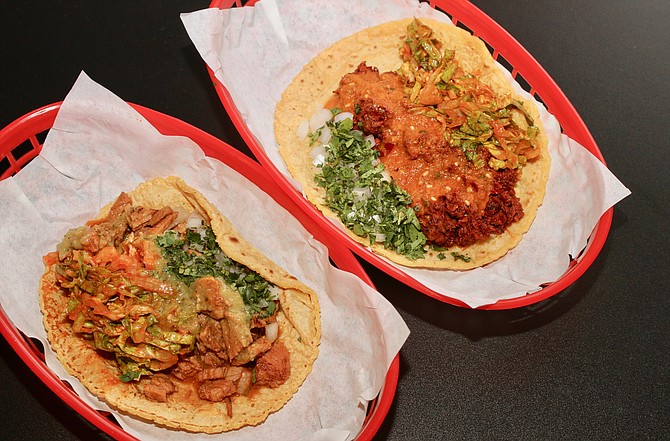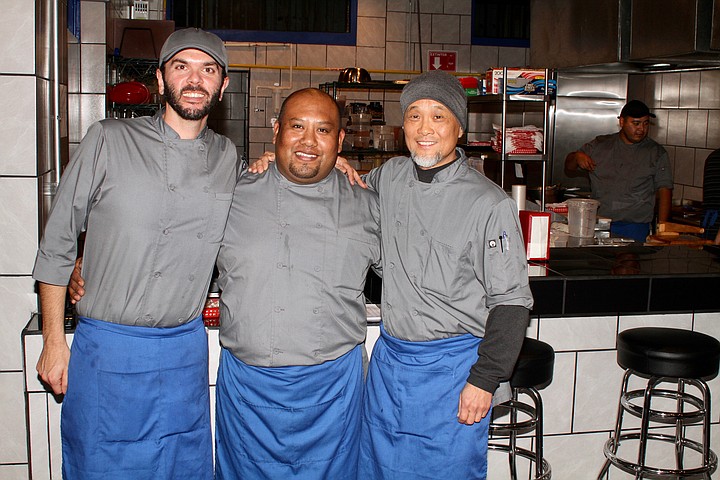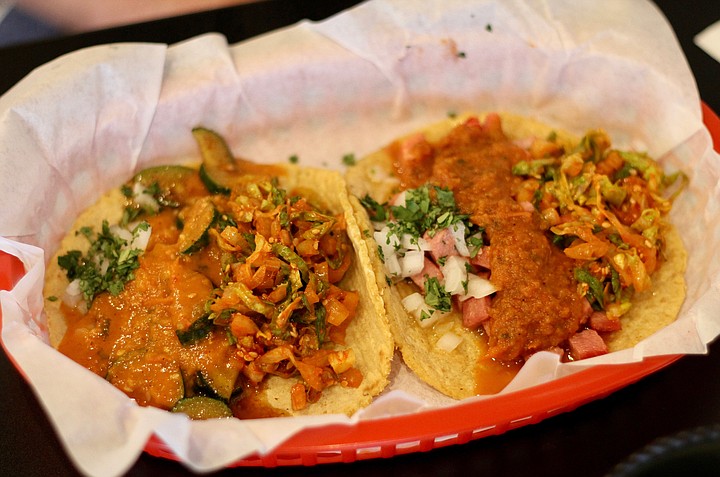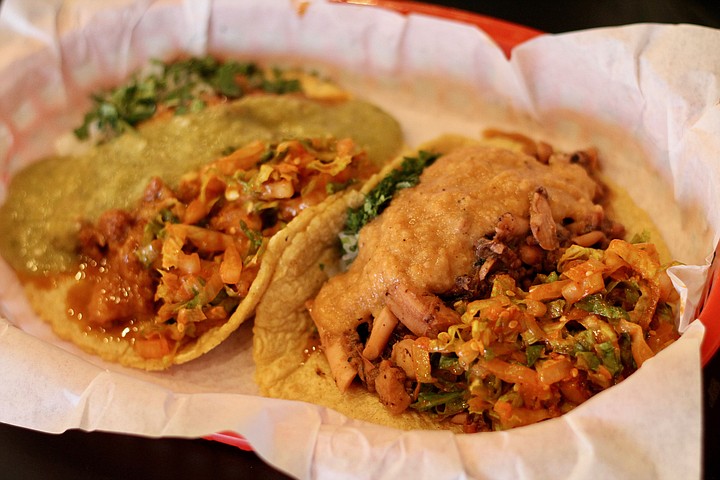 Facebook
Facebook
 X
X
 Instagram
Instagram
 TikTok
TikTok
 Youtube
Youtube

A Caucasian American and a Korean opened a taco shop in Tijuana in late November. It sounds like the beginning of a joke, but there is no punchline. KoMe is situated downtown on 7th Street near the corner with Constitución (a block away from Avenida Revolución).

The logo on two black signs above the doors and in their menu feature the Korean yin-yang rotated 90 degrees. The blue side bears the Korean flag and the red side features Mexico’s map shape. Two large doors give way to an all-tile open kitchen space with simple black tables and red metal foldable chairs. The menu offers eight types of Korean fusion tacos, each with its own salsa. All go for 25 or 35 pesos ($1.25 or $1.75). Mulitas and huaraches go for double the price, and quesadillas go for triple.

“We knew if we did a taquería, to do it right we had to have handmade tortillas,” says Anthony Zizzo. Since they opened I have visited several times. I am usually their only patron.

“When we made our banh mi tacos, we saw the response. We then thought there’s probably other options. My partner and I went up to sample Kogi food truck, and we knew that we had to change some things to accommodate Tijuanenses.”

Chefs Anthony Zizzo and Jin Son took a couple years to create their fusion. This is not their first Tijuana venture together. They are the ones behind Pequeño Saigon in Plaza Fiesta, a Vietnamese restaurant which has been going strong for four years. It was in this restaurant where they started to play with the idea of Asian and Mexican fusion.
The handmade tortilla is as good a tortilla as you are going to get. The in-house marinated meats, which are inspired by recipes from Jin Son’s family, have a distinct Korean BBQ flavor. The salsas have a purée consistency but lack a spicy kick. The tacos are topped with cilantro and onions on one side and a kimchi-like salad on the other.
The tacos are big, packed with ingredients, and served on top of a piece of paper in red small plastic baskets. They are juicy and complicated to pick up. It can be a messy eat.
The beef in red salsa consists of thin slices of marinated meat, bulgogi style, instead of your typical carne asada. The beef chorizo in orange salsa has a mushy consistency, which did not appeal to me. Pork in green salsa is similar to adobada and is the one that most resembles a regular taco.
The marlin with chipotle and tamarind salsa is the one I have enjoyed the most. KoMe uses cubed pinkish marlin pieces instead of the regular shredded marlin mix found in most seafood taco shops. I enjoyed the octopus with banana and guajillo salsa. Chunky pieces of octopus fair unexpectedly well with the semi-sweet salsa.
Though it consists of the same salsa as marlin, the chicken taco has a very Asian stir-fry with soy sauce taste. The vegan option of squash in orange salsa carries the same stir-fry sentiment. Both these tacos are more on the Korean side than Mexican.
Two big pieces of chewy and fatty chicharrón fell off the taco as I tried to get the first bite, giving me no choice but to eat with the fork. The chicharrón in salsa verde was my least favorite. I’m not a big fan of pork rinds. A friend of mine thoroughly enjoyed this taco, so if you like chicharrón, go for it.
I’ve only tried one mulita, and I chose beef in red salsa. Picking it up resulted in most of the ingredients falling into the basket. A mulita is like sandwich but with two tortillas. The bottom tortilla had a layer of melted cheddar and jack cheese, but the cheese flavor was lost with the strong flavor of the other ingredients.
On my most recent visit I decided to try the huarache with squash in orange salsa. A huarache is Náhuatl (Native Mexican) for shoe or sandal, but in food it is like an extended oval taco. I couldn’t even pick it up. It should come in a plate instead of the basket, because you must eat it with a fork and knife, and you end up cutting through the paper.
Both the mulitas and huaraches were a complicated eat. I’d rather default to tacos. The quesadilla remains a mystery. You can also mix and match the marinated meats with the salsas, giving you the option to further explore the fusion.


A Caucasian American and a Korean opened a taco shop in Tijuana in late November. It sounds like the beginning of a joke, but there is no punchline. KoMe is situated downtown on 7th Street near the corner with Constitución (a block away from Avenida Revolución).

The logo on two black signs above the doors and in their menu feature the Korean yin-yang rotated 90 degrees. The blue side bears the Korean flag and the red side features Mexico’s map shape. Two large doors give way to an all-tile open kitchen space with simple black tables and red metal foldable chairs. The menu offers eight types of Korean fusion tacos, each with its own salsa. All go for 25 or 35 pesos ($1.25 or $1.75). Mulitas and huaraches go for double the price, and quesadillas go for triple.

“We knew if we did a taquería, to do it right we had to have handmade tortillas,” says Anthony Zizzo. Since they opened I have visited several times. I am usually their only patron.

“When we made our banh mi tacos, we saw the response. We then thought there’s probably other options. My partner and I went up to sample Kogi food truck, and we knew that we had to change some things to accommodate Tijuanenses.”

Chefs Anthony Zizzo and Jin Son took a couple years to create their fusion. This is not their first Tijuana venture together. They are the ones behind Pequeño Saigon in Plaza Fiesta, a Vietnamese restaurant which has been going strong for four years. It was in this restaurant where they started to play with the idea of Asian and Mexican fusion.
The handmade tortilla is as good a tortilla as you are going to get. The in-house marinated meats, which are inspired by recipes from Jin Son’s family, have a distinct Korean BBQ flavor. The salsas have a purée consistency but lack a spicy kick. The tacos are topped with cilantro and onions on one side and a kimchi-like salad on the other.
The tacos are big, packed with ingredients, and served on top of a piece of paper in red small plastic baskets. They are juicy and complicated to pick up. It can be a messy eat.
The beef in red salsa consists of thin slices of marinated meat, bulgogi style, instead of your typical carne asada. The beef chorizo in orange salsa has a mushy consistency, which did not appeal to me. Pork in green salsa is similar to adobada and is the one that most resembles a regular taco.
The marlin with chipotle and tamarind salsa is the one I have enjoyed the most. KoMe uses cubed pinkish marlin pieces instead of the regular shredded marlin mix found in most seafood taco shops. I enjoyed the octopus with banana and guajillo salsa. Chunky pieces of octopus fair unexpectedly well with the semi-sweet salsa.
Though it consists of the same salsa as marlin, the chicken taco has a very Asian stir-fry with soy sauce taste. The vegan option of squash in orange salsa carries the same stir-fry sentiment. Both these tacos are more on the Korean side than Mexican.
Two big pieces of chewy and fatty chicharrón fell off the taco as I tried to get the first bite, giving me no choice but to eat with the fork. The chicharrón in salsa verde was my least favorite. I’m not a big fan of pork rinds. A friend of mine thoroughly enjoyed this taco, so if you like chicharrón, go for it.
I’ve only tried one mulita, and I chose beef in red salsa. Picking it up resulted in most of the ingredients falling into the basket. A mulita is like sandwich but with two tortillas. The bottom tortilla had a layer of melted cheddar and jack cheese, but the cheese flavor was lost with the strong flavor of the other ingredients.
On my most recent visit I decided to try the huarache with squash in orange salsa. A huarache is Náhuatl (Native Mexican) for shoe or sandal, but in food it is like an extended oval taco. I couldn’t even pick it up. It should come in a plate instead of the basket, because you must eat it with a fork and knife, and you end up cutting through the paper.
Both the mulitas and huaraches were a complicated eat. I’d rather default to tacos. The quesadilla remains a mystery. You can also mix and match the marinated meats with the salsas, giving you the option to further explore the fusion.
Comments